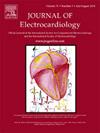High precision ECG digitization using artificial intelligence
IF 1.3
4区 医学
Q3 CARDIAC & CARDIOVASCULAR SYSTEMS
引用次数: 0
Abstract
Background
Digitization of paper-based electrocardiograms (ECGs) enables long-term preservation, fast transmission, and advanced analysis. Traditional methods for digitizing ECGs face significant challenges, particularly in real-world scenarios with varying image quality. State-of-the-art solutions often require manual input and are limited by their dependence on high-quality scans and standardized layouts.
Methods
This study introduces a fully automated, deep learning-based approach for high precision ECG digitization. In the normalization phase, a standardized grid structure is detected, and image distortions are corrected. Next, the reconstruction phase uses deep learning techniques to extract and digitize the leads, followed by post-processing to refine the signal. This approach was evaluated using the publicly available PMcardio ECG Image Database (PM-ECG-ID), comprising 6000 ECG images reflecting diverse real-world scenarios and smartphone-based image acquisitions. Performance was assessed using Pearson's correlation coefficient (PCC), root mean squared error (RMSE), and signal-to-noise ratio (SNR).
Results
The ECG digitization solution demonstrated an average PCC consistently exceeding 0.91 across all leads, SNR above 12.5 dB and RMSE below 0.10 mV. The time to ECG digitization was consistently less than 7 s. The average failure rate was 6.62 % across leads, with most failures occurring under extreme conditions such as severe blurring or significant image degradation. The solution maintained robust performance even under challenging scenarios, such as low-resolution images, distorted grids, and overlapping signals.
Conclusion
Our deep learning-based approach for ECG digitization delivers high-precision signals, effectively addressing real-world challenges. This fully automated method enhances the accessibility and utility of ECG data by enabling convenient digitization via smartphones, unlocking advanced AI-driven analysis.

利用人工智能实现高精度心电数字化
纸质心电图(ECGs)的数字化可以实现长期保存、快速传输和高级分析。数字化心电图的传统方法面临着重大挑战,特别是在具有不同图像质量的现实场景中。最先进的解决方案通常需要人工输入,并且受限于它们对高质量扫描和标准化布局的依赖。方法介绍了一种全自动、基于深度学习的高精度心电数字化方法。在归一化阶段,检测标准化的网格结构,并校正图像畸变。接下来,重建阶段使用深度学习技术提取和数字化引线,随后进行后处理以细化信号。该方法使用公开可用的PMcardio心电图像数据库(PM-ECG-ID)进行评估,该数据库包含6000张反映不同现实场景的心电图像和基于智能手机的图像采集。使用Pearson相关系数(PCC)、均方根误差(RMSE)和信噪比(SNR)评估性能。结果心电图数字化解决方案显示,所有导联的平均PCC始终超过0.91,信噪比高于12.5 dB, RMSE低于0.10 mV。心电图数字化时间始终小于7 s。引线的平均故障率为6.62%,大多数故障发生在极端条件下,如严重模糊或明显的图像退化。该解决方案即使在低分辨率图像、扭曲网格和重叠信号等具有挑战性的情况下也能保持稳健的性能。我们基于深度学习的心电数字化方法可提供高精度信号,有效应对现实世界的挑战。这种全自动方法通过智能手机实现方便的数字化,解锁先进的人工智能驱动分析,增强了心电数据的可访问性和实用性。
本文章由计算机程序翻译,如有差异,请以英文原文为准。
求助全文
约1分钟内获得全文
求助全文
来源期刊

Journal of electrocardiology
医学-心血管系统
CiteScore
2.70
自引率
7.70%
发文量
152
审稿时长
38 days
期刊介绍:
The Journal of Electrocardiology is devoted exclusively to clinical and experimental studies of the electrical activities of the heart. It seeks to contribute significantly to the accuracy of diagnosis and prognosis and the effective treatment, prevention, or delay of heart disease. Editorial contents include electrocardiography, vectorcardiography, arrhythmias, membrane action potential, cardiac pacing, monitoring defibrillation, instrumentation, drug effects, and computer applications.
 求助内容:
求助内容: 应助结果提醒方式:
应助结果提醒方式:


